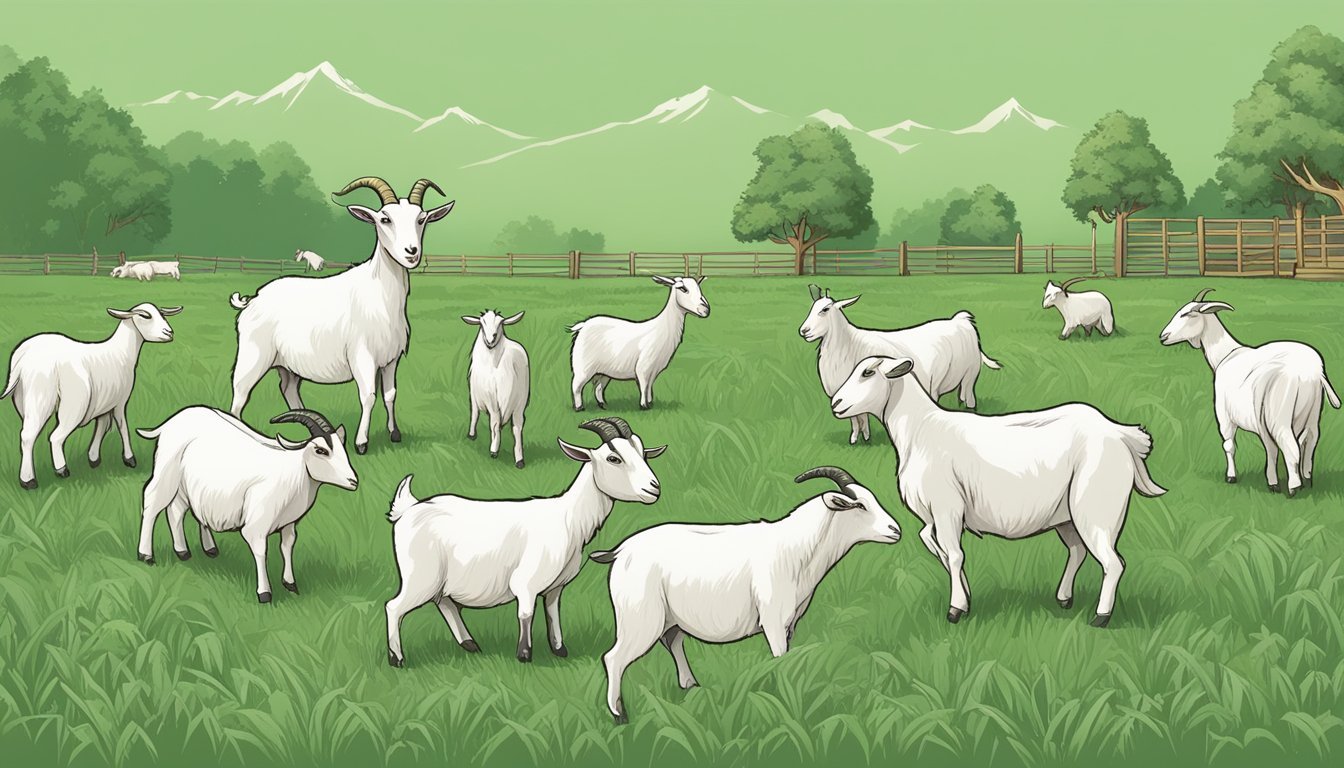The Truth About Goat Milk Allergies
Identifying Symptoms and Effective Management Strategies
Goat milk is often considered a healthful alternative to cow's milk, but for some individuals, goat milk allergies can present a serious concern. Just like any food allergy, goat milk can trigger adverse reactions that vary in severity from person to person. It's important for those susceptible to food allergies to understand the signs and symptoms associated with a goat milk allergy, which may appear within minutes or take a couple of hours after consumption. Symptoms are consistent with other food allergies and can range from mild to severe, with some individuals experiencing systemic reactions.
Managing a goat milk allergy involves careful avoidance of goat milk and products containing goat milk proteins. Cross-reactivity can occur in individuals with cow's milk allergy, as the proteins in both types of milk share similarities, potentially leading to a reaction from both. Diagnosis and management typically require consultation with an allergist. Proper understanding and management of goat milk allergies are key to minimizing risks and maintaining a safe and healthy diet for those affected.
Understanding Milk Allergies
Milk allergies involve the immune system's reaction to proteins in milk. These allergies differ from lactose intolerance and can result in various allergic reactions.
Difference Between Milk Allergy and Lactose Intolerance
Milk allergy is an immune system response to milk proteins like casein and whey, manifesting in IgE mediated or non-IgE mediated allergic reactions. In contrast, lactose intolerance stems from the digestive system's inability to break down lactose, a sugar in milk, due to a deficiency in the lactase enzyme. People with milk allergies can experience symptoms ranging from hives to anaphylaxis, while lactose intolerance primarily causes digestive discomfort.
Role of Casein and Whey in Allergies
Casein and whey are the main proteins in milk that can trigger allergic responses. Casein constitutes about 80% of the protein content in cow's milk and is a common culprit in milk allergies, while whey makes up the remaining 20%. When a person with a milk allergy consumes these proteins, their immune system erroneously identifies them as harmful, leading to an allergic reaction.
Immunoglobulin E (IgE) Mediated Reactions
IgE mediated reactions are the most common type of immune response in milk allergies. When an individual with a milk allergy ingests milk proteins, their body produces Immunoglobulin E antibodies, which bind to the proteins and trigger the release of histamine. This release can cause a range of symptoms, including skin reactions, gastrointestinal distress, respiratory issues, and in severe cases, anaphylaxis.
Non-IgE Mediated Allergies
Non-IgE mediated allergies, although less common, are a type of food allergy in which symptoms may appear more gradually than IgE mediated reactions. This delayed allergic response is not mediated by Immunoglobulin E, but rather involves other components of the immune system. Symptoms can include gastrointestinal issues, skin rashes, or respiratory problems, but typically do not lead to anaphylaxis.
Identifying Symptoms of Goat Milk Allergy
When a person has an allergy to goat's milk, their immune system reacts to the proteins found in the milk as if they were harmful invaders. This reaction can trigger a variety of symptoms which may occur immediately or develop over a few hours. It's crucial to recognize these symptoms promptly to manage the condition effectively and seek appropriate treatment if necessary.
The symptoms of goat milk allergy can affect different parts of the body, manifesting as skin, gastrointestinal, and respiratory issues. Here are common signs to look out for:
Skin Reactions:
Hives (Urticaria): Red, itchy welts that may appear on the skin.
Eczema: Itchy, inflamed skin.
Angioedema: Swelling beneath the skin, often around the eyes and lips.
Gastrointestinal Problems:
Nausea: A feeling of sickness with an inclination to vomit.
Vomiting: Forceful expulsion of stomach contents.
Diarrhea: Frequent, loose, or watery stools.
Abdominal Pain: Can be cramping or persistent pain.
Gas and Bloating: Discomfort from an increase in digestive gas.
Respiratory Issues:
Wheezing: High-pitched whistling sounds when breathing out.
Cough: A reflex to clear the airway of mucus or irritants.
Runny or Stuffy Nose: Increased mucus production in the nasal passages.
In severe cases, Goat Milk Allergy can cause anaphylaxis, a potentially life-threatening reaction characterized by swelling of the throat, difficulty breathing, a severe drop in blood pressure, and rapid pulse. This is an emergency requiring immediate medical attention. Histamine, a compound released by the body during allergic reactions, contributes to many of these symptoms. Recognizing the link between the consumption of goat's milk and these symptoms is key to managing the allergy.
Comparison to Cow's Milk Allergy
When discussing milk allergies, it is crucial to understand that goat milk and cow's milk contain different protein structures, and individuals allergic to one may not necessarily be allergic to the other. However, cross-reactivity is possible due to similarities in protein composition.
Goat Milk vs. Cow's Milk Protein Structures
Goat milk and cow's milk have distinct protein structures, impacting how they are digested and potentially provoke an allergic response. The primary proteins found in milk are casein and whey. Cow's milk contains about 80% casein, while goat milk has a slightly different casein composition that may be easier for some individuals to digest. The alpha S1-casein concentration is lower in goat milk, and this protein is often associated with cow's milk allergies (CMA).
Moreover, the lactose content in goat milk is only nominally lower than that of cow's milk, so while it might be a suitable alternative for individuals with mild lactose sensitivities, it is unlikely to benefit those with lactose intolerance.
Cross-Reactivity Between Different Animal Milks
The concept of cross-reactivity is significant in discussing milk allergies. Cow's milk proteins can cross-react with those in goat milk, meaning that individuals allergic to cow's milk can potentially exhibit a similar allergic response to goat milk. Studies have found that approximately 90% of people with a cow’s milk allergy also react to goat milk.
Despite this, goat milk is sometimes considered in milk alternatives for those with sensitivities to cow's milk, largely because it may be better tolerated by some individuals without a true CMA. It remains essential for anyone with a suspected milk protein allergy to consult a healthcare professional before incorporating or substituting new dairy or milk products into their diet.
Given the potential for cross-reactivity, it's recommended that individuals with CMA consult with a healthcare provider and consider an allergy test specifically for goat milk before attempting to replace cow’s milk with goat milk in their diet.
Demographic Considerations
When examining goat milk allergies, distinct demographic groups manifest varying degrees of susceptibility and symptoms. Infants and young children, who are in critical stages of immune system development, may be more vulnerable to developing allergies due to immature gut barriers and immune responses. Whereas, adults may develop allergies to goat's milk protein after years of tolerance, potentially due to changes in immune function or new sensitizations.
The propensity for allergic reactions to goat milk should be a concern for patients with existing dairy allergies, as there may be cross-reactivities with cow's milk protein. A study highlights a 27-year-old patient with allergic symptoms to goat milk who did not show a reaction to cow's milk, which may indicate variable allergic profiles among different mammalian milks.
In terms of risk factors across demographics, genetic predispositions, environmental exposures, and childhood diet play significant roles in the development of food allergies. Infants introduced to diverse food proteins at an earlier age might develop tolerance, while others may become sensitized, thus increasing the risk of allergies.
Risk Factors for Infants and Young Children:
Family history of allergies
Delayed introduction to potential allergens
Presence of atopic dermatitis
Factors for Adults:
Sudden changes in diet
Prolonged exposure to allergenic substances
Coexisting respiratory conditions like asthma
This immune system complexity requires thorough assessment by healthcare providers, especially when introducing goat's milk to those at higher risk for allergies.
Common Triggers and Sources of Exposure
Goat milk allergies are caused by an adverse immune reaction to the proteins found in the milk. Individuals with this allergy must be vigilant about what they consume and the ingredients in various products. Exposure to allergens can occur through direct ingestion or by coming into contact with surfaces or substances that contain goat milk.
Direct Sources:
Dairy Products: Beyond the obvious source of goat's milk, dairy products made from goat's milk, including cheese, yogurt, and butter, should be avoided.
Baked Goods: Many baked goods can contain goat milk or butter. It is important to check labels or inquire about ingredients when purchasing or consuming these items.
Chocolate: Some types of chocolate are made with milk, and while cow's milk is most common, goat's milk can also be used.
Cross-Contamination:
Shared Equipment: Cross-contact with goat milk can happen when equipment is shared between cow milk and goat milk products without thorough cleaning.
Utensils and Surfaces: Kitchen tools and surfaces may inadvertently expose a person to goat milk proteins if not properly cleaned after contact with the allergen.
Hidden Sources:
Processed Foods: Many processed foods use milk products for flavor and texture; hence, always check labels for goat milk or any dairy listing.
Cosmetics and Soaps: Some personal care items may contain goat milk, so it's crucial to read product labels.
Patients diagnosed with a goat milk allergy should be instructed to read product labels rigorously and may likely require an allergist's guidance to identify less obvious sources of exposure. For safety, carrying an epinephrine auto-injector in case of unintentional ingestion and anaphylaxis is often recommended. Additionally, they should consider visiting reputable medical sources like the Mayo Clinic and the Cleveland Clinic for further information on managing their allergy.
Diagnostic Procedures
When assessing for goat's milk allergy, healthcare providers typically begin with a physical examination and a thorough review of the patient's symptoms. If a milk allergy is suspected, they may refer the patient to an allergist for further evaluation.
Two common tests utilized for diagnosis are:
Skin Prick Test: This procedure involves placing a small amount of the goat's milk allergen on the patient's skin, usually on the forearm, and then pricking the skin so the allergen goes under the surface. A positive reaction, typically swelling and redness, indicates an allergy.
Blood Test: Specifically, an IgE serum test can be conducted to measure the presence of immunoglobulin E antibodies to goat's milk proteins in the patient's blood.
In some cases, doctors might recommend an elimination diet, followed by a food challenge, to confirm the allergy. During an elimination diet, goat's milk and products containing it are removed from the diet, then gradually reintroduced under controlled conditions to monitor for allergic reactions.
For those confirmed to be allergic to milk, immunotherapy may not be a standard treatment due to variations in individual reactions and the potential for severe responses; avoidance remains the key management strategy.
Skin Prick Test: Detects immediate allergic reactions to specific allergens.
Blood Test: Measures IgE antibodies to identify allergen sensitivities.
Elimination Diet: Observes for symptom resolution upon allergen removal.
Management and Treatment Options
Managing goat milk allergies involves a two-pronged approach: being prepared to deal with emergency situations such as anaphylaxis and developing a long-term strategy to avoid allergens and maintain nutritional balance.
Emergency Response to Anaphylaxis
In the event of severe allergic reactions, prompt medical emergency response is crucial. Anaphylaxis, a life-threatening allergic reaction, requires immediate administration of epinephrine to counteract symptoms. Individuals with known severe food allergies should carry an epinephrine auto-injector at all times. After administering epinephrine, one should seek emergency medical assistance immediately as symptoms can recur, and further treatment may be necessary.
Long-Term Allergy Management
Long-term management of goat milk allergy is centered on prevention and education. Working with an allergist is essential to create a comprehensive plan that includes recognizing allergens, understanding allergen labeling, and learning how to respond to accidental exposures. Patients will also learn coping strategies and how to educate those around them about the food allergy. Dietary management typically involves avoiding goat milk and related products.
Nutritional Considerations and Substitutes
Individuals avoiding goat milk must ensure they still receive adequate nutrition. This includes finding substitutes for the key nutrients found in goat milk, such as calcium, vitamin D, and proteins. Alternatives may include lactose-free milk or plant-based milks—such as almond, soy, or coconut milk—fortified with calcium and vitamin D. Enzymes, like lactase, might be recommended for those with lactose intolerance, while lactoferrin supplements could assist in managing some allergic symptoms. However, these enzymes are not a solution for a true milk allergy. Patients should consult with healthcare providers to tailor their diet correctly.
Precautions and Preventive Strategies
Managing goat milk allergies effectively involves employing strategic precautions to minimize the risk of allergic reactions. These preventive strategies are pivotal in safeguarding individuals, particularly those with sensitive immune systems, from exposure to allergens that could trigger adverse responses.
Avoidance of Goat Milk in Diets
To prevent goat milk allergy symptoms, it is crucial to eliminate goat milk and its derivatives from one’s diet. Since goat milk proteins can induce allergic reactions in some individuals due to cross-reactivity with cow milk proteins, careful dietary management is necessary. Those at risk should substitute goat milk with non-dairy alternatives rich in calcium and vitamin D to maintain nutritional balance.
Reading Food Labels for Hidden Allergens
Diligent reading of food labels is imperative to identify hidden goat milk allergens in foods. Ingredients to watch for include casein, whey, and lactose, which are potential indicators of milk content. It is important to note that food labeling regulations may differ depending on the country, so staying informed on local guidelines is beneficial for effective allergy management.
Educating Caregivers and Schools
Education is a powerful tool in allergy prevention. Informing caregivers and school personnel about the severity of food allergies and the potential for cross-contact can significantly reduce the risk factors associated with accidental exposure. By empowering those responsible for food preparation and oversight with knowledge about goat milk allergy, one can better ensure a safe environment for affected individuals.
Exploring Milk Alternatives
When managing milk allergies or lactose intolerance, finding suitable milk substitutes is essential. Milk alternatives provide a variety of options for individuals to enjoy similar textures and tastes as dairy milk without the allergens associated with cow's milk.
Soy Milk: One of the most popular dairy substitutes, soy milk, is made from soybeans. It is a good source of protein and can be fortified to provide calcium, vitamins A and D, and is naturally lactose-free.
Almond Milk: Made from almonds, this milk alternative provides a nutty flavor and a lighter texture. While it is lower in protein, it often comes enriched with calcium and vitamin D. Almond milk is also lactose-free and a favorite for those with a more calorie-conscious diet.
Rice Milk: The least allergenic of milk alternatives, rice milk is made from rice. It is high in carbohydrates and low in protein, and usually fortified with vitamins and minerals including calcium.
Oat Milk: A newer addition to the milk alternative scene, oat milk is derived from whole oat grains. It provides a creamy texture similar to dairy milk and can be fortified with calcium and vitamins. It's also a good option for those avoiding nuts and soy.
Soy Milk: Base Ingredient - Soybeans, Protein content - High, Fortification options - Calcium, Vitamins A, D
Almond Milk: Base Ingredient - Almonds, Protein content - Low, Fortification options - Calcium, Vitamin D
Rice Milk: Base Ingredient - Rice, Protein content - Low, Fortification options - Calcium, Vitamins A, D
Oat Milk: Base Ingredient - Oats, Protein content - Moderate, Fortification options - Calcium, Vitamins
When choosing a milk alternative, they should consider the nutritional profile in relation to their dietary needs. Lactose intolerance sufferers may find that these milk alternatives can be comfortable substitutes. However, it's important to read labels for added sugars and preservatives to make informed dietary choices.
Patient Prognosis and Quality of Life
When discussing the prognosis of patients with goat's milk allergies, it is typically positive. Many children with this condition experience improvement and often outgrow the allergy between the ages of 3 to 5 years. However, it's important to note that some individuals may continue to have the allergy throughout their lifetime. Management through a carefully modified diet, excluding goat's milk and related products, allows most patients to cope effectively.
The quality of life for patients can remain high, provided they have access to accurate diagnosis and appropriate management strategies. Healthcare providers play a crucial role in ensuring this by educating patients and their families on avoiding exposures and identifying potential allergic reactions promptly.
Symptoms of goat's milk allergy can range from mild to severe, and in cases of accidental ingestion, rapid response can prevent serious complications. Here are common symptoms that patients may experience:
Mild Symptoms: hives, itching, skin rash
Moderate Symptoms: gastrointestinal discomfort, vomiting
Severe Symptoms: anaphylaxis, a potentially life-threatening reaction that requires immediate medical attention
In the management plan, healthcare providers will outline steps to avoid allergic reactions, which typically involve:
Reading food labels carefully
Being vigilant when eating out
Carrying prescribed medications, such as antihistamines or epinephrine auto-injectors
Patients and their support networks need to remain informed and proactive in managing the allergy. With adherence to medical advice and avoidance strategies, individuals with goat's milk allergy can expect to maintain a good quality of life without significant limitations.
Additional Considerations
When addressing goat milk allergies, it's important to consider the broader implications, including the potential for cross-reactivity with other allergies and the psychosocial impacts. These aspects play a critical role in the comprehensive management of milk allergies.
Other Allergies and Cross-Reactivity
Individuals with goat milk allergy may also experience cross-reactivity with cow's milk due to similar protein structures. Cow's milk allergy (CMA) is among the most commonly identified in children, and those with CMA may react similarly to goat milk. The proteins causing these reactions are often casein and whey, and individuals may also react to lactoferrin, a globular protein. Furthermore, there is a risk of reacting to food protein-induced enterocolitis syndrome (FPIES), a severe gastrointestinal reaction triggered by the ingestion of certain foods, including milk. Understanding the potential for cross-reactivity is essential for accurate diagnosis and prevention of serious health issues.
Atopic Dermatitis: This can be a sign of milk allergy, characterized by erythema and pruritus (itching).
Pets: Some individuals allergic to goat milk may also have allergies to animal dander from pets like cats and dogs.
Psychosocial Impact of Milk Allergies
The psychosocial dimension of milk allergies cannot be overlooked. Living with milk allergies can impose dietary restrictions that lead to feelings of isolation or difference, especially in social settings such as schools or family gatherings. Care is needed to ensure that individuals, especially children, do not feel excluded and that alternative nutritional sources are made available to them. Replacement of milk requires careful attention to nutritional adequacy, ensuring the intake of essential vitamins and minerals from other food sources or supplements.
Social Situations: Proactively managing the dietary needs of those with milk allergies is crucial in social contexts to mitigate feelings of exclusion.
Severe Reactions: The risk of severe reactions necessitates that individuals, caregivers, and peers are educated on the prompt recognition and management of symptoms, including the use of emergency medication like epinephrine.









